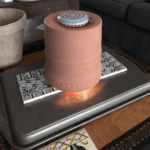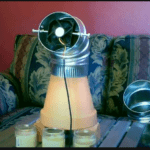Though it may appear counterintuitive, this DIY survival heater can provide an efficient way to stay warm in a tent. Relying on heat transfer and thermal mass of clay pots, this method utilises their ability to transmit warmth.
Contrary to popular belief, single candles cannot generate more than a few BTUs of heat; however, multiple candles used together can increase its heating power significantly.
Warmth Transfer
An alternative heating method that’s both energy-saving and environmentally-friendly, candle convection heaters are an interesting idea that’s quick and easy to create. All it requires are Terra-Cotta pots with lids on them, washers and nuts as well as some candles; their thermal mass helps retain and radiate the heat around your room – saving money on utility costs while lowering carbon footprints simultaneously!
However, many are skeptical of claims that one candle can warm a room effectively. A single candle doesn’t produce a lot of heat; its flame burns out within hours; furthermore, its temperature increase only amounts to several degrees compared with what can be gained with using space heaters and other forms of alternative heating methods.
Candles generate their heat through chemical reactions within their flame that produce thermal energy, which is transferred from this hot flame into the wax surface and air surrounding it. Because warmer regions have lower density than cooler ones, heat rises as it moves upwards until being replaced by cooler air from above and the process repeats itself.
The hottest area near a candle flame is usually its immediate surroundings; however, some of this heat can also be transferred onto the surface of a pot and slowly radiate throughout a room. Furthermore, its thermal mass helps the warmth dissipate faster compared to simple candles.
Nesting two pots together will increase thermal mass and prolong heat delivery, providing more heat for longer. You can construct this variation of this heater using a metal rod secured with washers and nuts; after two hours you can measure both temperatures to see if there has been any noticeable impact.
Radiation
Heat generated by candles comes not from its flame or its wick, but rather from atoms and molecules of wax itself, when their vibration absorbs infrared radiation, emitting it away from you without actually heating your finger directly.
Radiant heat can provide warmth in an emergency power outage situation, but it shouldn’t replace portable space heaters – they have much greater heating capacities and are more effective at turning electricity into useful heat.
Simple candle convection heaters can be created by elevating two terracotta pots on bricks, placing candles inside one or both pots, and lighting them. The theory holds that this combination amplifies heat generated from burning candles; this, of course, doesn’t work and violates basic thermodynamic principles.
Candles produce only minimal heat themselves, and most of what heat they do produce quickly dissipates into the atmosphere above your head or is lost when reaching your ceiling and reflecting back off it – meaning you may never really experience its warmth directly beneath a burning candle.
Making a candle heater requires placing the container containing your candle(s) atop a multi-core steel and ceramic radiator with solid steel inner core secured to Three Legged Steel Stand using solid brass chains, then using containers as thermal batteries to store its heat close to the floor of your home.
Jars and other containers help protect candles from wind-driven gusts of air that could blow them out and start fires, with tight lids being ideal. Keep in mind that candles pose serious fire hazards; never leave an unattended flame burning! Hundreds of homes and lives have been lost every year because people opting for non-electrical methods of lighting and heating that include using naked flames as lighting or heating sources.
Convection
TikTok users have taken to sharing a new life hack that’s said to reduce energy bills: placing a candle under an upturned terracotta pot (or similar) with its lid tilted downward and lighting it will “warm your room”, but does this really work?
A clay pot heater works on the principle of convection, or movement of hot particles through fluid, caused by thermal expansion – hot particles expand more than cold ones, which causes them to rise and displace denser particles more quickly, keeping a room warm by keeping air circulating around its center. This keeps things moving around within it.
Candles emit small amounts of radiant heat which spreads outwards from their flame. But the terracotta pot can absorb some of this radiant heat and transfer it through convection into the surrounding air, warming it further up by convection than without its presence; without its help, candles would just emit their radiant heat straight into the atmosphere without increasing temperatures much.
One may believe that adding a clay pot produces more heat than another; however, according to the first law of thermodynamics this does not change the overall energy produced by a candle; rather it only does so more efficiently by turning all light energy into heat more efficiently than any other method (tin can or cupped hand may work similarly well).
Terracotta pots provide the candle with extra insulation and draft-freeness, helping it remain lit longer for heating purposes. However, remember that single candles cannot produce enough heat to provide real room warming – on average one medium-sized candle produces about 120-130 BTUs an hour depending on its type; but this amount represents only a very tiny portion of what would be necessary in an average room with proper insulation and draft freeness.
Safety
Candle heaters, as their name implies, consist of an insulated container containing either a candle or jar containing wax to help distribute heat efficiently. Candle heaters can serve as an effective alternative to propane camp stoves when camping without power, or during emergencies at home when there’s no furnace available to heat the home.
Though candle heaters may provide adequate warmth in small spaces, it is important to remember their inherent danger – being highly flammable – should they be left unattended. Furthermore, using such devices for all your heating needs in drafty or very cold rooms would take much longer for producing enough warmth than conventional sources would.
Candle heaters pose additional threats than fire when burning, including chemical releases when paraffin wax used in most candles is consumed by fire. Paraffin wax contains toluene and benzene which have both been identified as known carcinogens; furthermore, soot inhalation may cause respiratory irritation.
Terracotta pots may help contain flames, but their use does not contribute to improving this type of heating device’s functionality. A better choice would be using a metal tin instead, which could double up as both cooking vessel and element resistant shield. Tin will also stand up better against extreme temperatures than its clay-coated counterpart and be less likely to crack or break when exposed.
Tins provide additional protection from wind gusts that could blow the flames away and start a fire, melting wax into an inferno-sized fireball that poses serious safety risk. Treat these type of fires like oil fires – by either smothering it out quickly with something such as an extinguisher or spraying them down immediately to bring down flames or extinguish them completely with water sprayers.
To avoid this scenario, use a large tin or metal can and place it away from anything that can catch fire, including clothing and blankets. The tin will help prevent wax from melting all at once, decreasing chances of sparks or flameouts and prolonging heat retention within its walls. It will also prolong its heat retention for increased warmth when warming an area.





